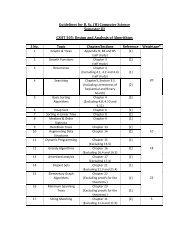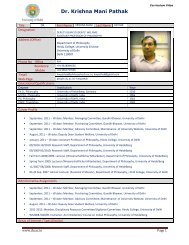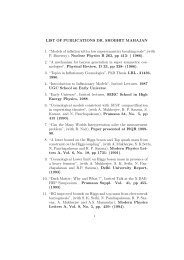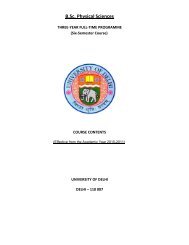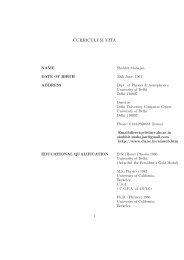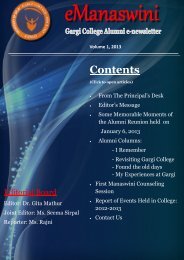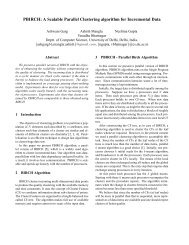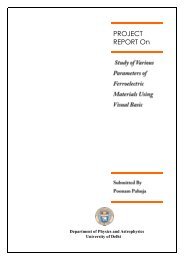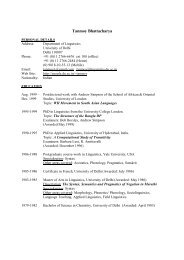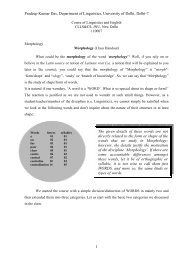Book-Review Thich Nhat Hahn, Understanding Our Mind, New Delhi ...
Book-Review Thich Nhat Hahn, Understanding Our Mind, New Delhi ...
Book-Review Thich Nhat Hahn, Understanding Our Mind, New Delhi ...
- No tags were found...
Create successful ePaper yourself
Turn your PDF publications into a flip-book with our unique Google optimized e-Paper software.
<strong>Book</strong>-<strong>Review</strong><strong>Thich</strong> <strong>Nhat</strong> <strong>Hahn</strong>, <strong>Understanding</strong> <strong>Our</strong> <strong>Mind</strong>, <strong>New</strong> <strong>Delhi</strong>: HarperCollinsPublishers India, 2008. Rs.295. ISBN: 978-81-7223-796-7.The <strong>Book</strong> <strong>Review</strong>, No. XXXIII, Vol. 5, 2009: 10-11.<strong>Thich</strong> <strong>Nhat</strong> <strong>Hahn</strong>, a Buddhist Zen master of Vietnamese origin, is a human rightsactivist and a renowned organizer of retreats on the art of mindful living. Thây(‘teacher’), as he is generally known to his followers, also pioneered “engaged”Buddhism during the Vietnam War when he gave a call to interlink meditationpractices and social activism. Since then, he has been engaging spirituality incommunity-building, peace-making, and deep ecology. He has written over onehundred books which include popular titles such as Being Peace (Parallax Press,1996), The Art of Power (HarperOne, 2007), The Miracle of <strong>Mind</strong>fulness (BeaconPress, 1996), Present Moment Wonderful Moment (Parallax Press, 1990), andCalming the Fearful <strong>Mind</strong> (Parallax Press, 2005). Nominated in 1967 for theNobel Peace Prize by Martin Luther King Jr., <strong>Thich</strong> <strong>Nhat</strong> Hanh has perfected hisweltanschauung through practical experience at his three centres known as PlumVillage (Southern France), Green Mountain Dharma Center (Vermont, USA), andDeer Park Monastery (California, USA). Environmental activists, yoga teachers,psychotherapists, care-givers, community workers, and artists irrespective ofgender, class, race, religion, and nationality approach him for cultivation ofmindfulness, wholesomeness, inner tranquility, and spirituality.<strong>Thich</strong> <strong>Nhat</strong> <strong>Hahn</strong>’s <strong>Understanding</strong> <strong>Our</strong> <strong>Mind</strong>, is the revised paperbackedition of the previously released Transformation at the Base: Fifty Verses on theNature of Consciousness (Parallax Press, 2001). Finalist for the 2001 NautilusAward, this seminal work on Buddhist applied psychology contains a newintroduction by Dharma teacher Reb Anderson, author of Being Upright. Thisbook, a compilation of dharma teachings given by <strong>Thich</strong> <strong>Nhat</strong> Hanh between 1989and 1998 on Buddhist psychology, is based on fifty verses on the nature ofconsciousness taken from the great fifth century Buddhist master Vasubandhu andthe teachings of the Avatamsaka Sûtra.Study of human mind has always been an important subject in Buddhism.For instance, the opening verse of the Dhammapada says: “<strong>Mind</strong> precedes (all)states, (that have) mind as a master, (and are) produced by mind. If (one) eitherspeaks or acts with a corrupted mind, then suffering follows him, like the wheel(following) the foot of the bearer (i.e., ox).” The underlying goal of this book byThây, as the title shows, is also study of human mind. Through the presentation ofthe basic teachings of Buddhist applied psychology, Thây points out that our mindis a field in which every kind of seed is sown on a daily basis through our thoughts,words, and deeds, and “what these seeds generate becomes the substance of ourlife” (p. 25). Thus, he points out, one can cultivate either paradise or hell in one’sown mind (p. 54) by sowing unwholesome and/or wholesome seeds (p.26).10
Further, consciousness receives and is impregnated with all the experiences andperceptions that come to us and then become seeds in our store consciousness.Each of these seeds is stored there, unmanifested, until the conditions for itsmanifestations are present (p.33). He further points out that as a result of themanifestation of unwholesome seeds in our consciousness, our mind distorts ourperception and we are tricked into believing that our perception of reality iscorrect. This leads us to erroneous conclusions about things around us. Hence “allour suffering arises from our failure to recognize things as they are”(p.30). Inother words, whether we have happiness or not depends on the seeds that arestronger in our store consciousness (p.45). These seeds remain hidden deep in aperson’s consciousness and he/she becomes aware of them only when they matureand manifest in that person’s mind consciousness. “If there are strong seeds ofunhappiness, anger, discrimination, and delusion, he will suffer greatly, and it islikely that through his actions he will water these unwholesome seeds in others. Ifhis seeds of understanding, compassion, forgiveness, and joy are strong, not onlyis he capable of true happiness but he will be able to water the seeds of happinessin others.” (p.46). However, when the seeds are dormant, we cannot see them(p.58) and we can recognize and nourish the wholesome seeds within ourselves aswell as in others by practicing mindfulness (pp.26-27). Thây believes that each seedin our store consciousness is both individual and collective at the same time: “Thecollective is made of the individual, and the individual is made of the collective”(p.41). According to him, “the collective aspect of seeds in our consciousness alsocomes from our ancestors and from all those who have gone before us. The seedsin our consciousness contain the experiences, ideas, and perceptions of manypeople throughout space and time”(p.43). The conceptual base laid out by Thâyin <strong>Understanding</strong> <strong>Our</strong> <strong>Mind</strong> has some commonalities with Carl Jung, according towhom, the emotions and experiences of suffering and happiness in our minds alsoreflect collective consciousness (p.43).According to Thây, each of us is an aggregation of our actions which inturn are both the cause and result of seeds in our store consciousness. Each of ouractions sows seeds in our consciousness, and our store consciousness preservesand maintains these seeds. When we die and transform from one form of being toanother, the seeds of our actions as well as the seeds that we receive from ourancestors, friends, and society, travel with our store consciousness acrossgenerations (pp.38-49).“<strong>Our</strong> seeds carry the habit energies of thousands of years....Because of habit energies, we are not able to perceive things as they truly are. Weinterpret everything... in terms of our habit energy. If you crumple a sheet of paper,it is difficult to make it lie flat again. It has the habit energy of being crumpled. Weare the same” (p.49). However, it is possible for us to change our habit energieswhich are the fruit of our behavior, formed by the environment in which we live aswell as our reactions to things. Thây points out that through the practice ofmindfulness, we can observe our habit energies and begin to transform them (p.50).Moreover, through the practice of mindfulness we can create new and more11
functional habit energies (p.51). “We have to recognize, embrace, and transformour negative habit energies and train ourselves to have more positive habitenergies.... These positive habits need to be cultivated, because our negative habitsalways push us to do and say things that bring suffering to ourselves and others”(p.52).Following the Mahâyâna tradition, Thây points out that each of uspossesses the inherent quality of enlightened mind (i.e. Buddha nature) and whatwe need to do is nurture this quality (p.26). If we do that, we can reach the fieldof things-in-themselves, the world of suchness (tathatâ). However, the nature ofour mind is obstructed (parikalpita). This means that “we build a world full ofillusion for ourselves because of the distorted way we perceive reality.... To get tothat reality, we have to let go of the images we create in our consciousness” (p.57).Thus, we need to correct the tendency to discriminate and think dualistically, sothat the reality of ourselves and then the reality of the world may have a chance toreveal itself (p.57). By practising Right Effort (samyaka vyâyâma, part of theNoble Eightfold Path) we can recognize and water the wholesome seeds inourselves and others. By doing so, we can also prevent the unwholesome seedsthat have not yet manifested from manifesting and to help the unwholesome seedsthat have already arisen in our mind consciousness to return to storeconsciousness. Similarly, by practising Right Effort we can water the wholesomeseeds in our store consciousness that have not yet arisen (pp.46-47). “A few weeksor months of practicing in order to transform can help ripen the wholesome seedsin us and bring about a new life... (and put us) on the path of maturation” (p.67).Thây says that not only mental formation but physical and physiologicalformations also are manifestations from seeds in our store consciousness (p.118).Moreover, as our store consciousness is always flowing and changing, it can betransformed and when we transform the seeds in our store consciousness, it istransformation at the base (p.71). Moreover, our store consciousness cannot existby itself alone and its true nature is neither individual nor collective, butsimultaneously individual and collective. “After removing notions of completeindividuality and complete collectivity, we can begin to see the real nondual natureof store consciousness” (p.77). “We should strive to learn to identify all thepositive and negative seeds in us.... (and)... in our relationship” (p.80). Thus, if werefrain from watering the negative seeds of a person we love and only water his/herpositive seeds, then it will bring about positive change in the other person, andthese positive changes will come back to you in the form of greater joy, peace, andhappiness (p.80). Speaking deep-ecologically, Thây points out that we know that“we have lungs for breathing in and out. But when we look more deeply, we cansee that the mountains and forests are also our lungs. Without them, we could notbreathe in and out either.... We see that our body is the body of the cosmos, andthat the cosmos is our own body. This insight is only possible when we see throughnotions of inside and outside, self and other ” (p.83).12
Thây points out that our habit energies, delusions, and craving cometogether and create a tremendous source of energy (he calls it manas) thatconditions our actions, speech, and thinking. This manas hinders the functioningof the store consciousness and gets in the way of transforming the seeds. The modeof perception of manas is always false... creating and maintaining erroneousperceptions (p.91). “<strong>Our</strong> mind is enslaved when it is picked up and embraced as a‘self’ by manas” (p.93). “The nature of manas is delusion, ignorance, anddiscrimination. It is imprisoned in its delusion and its craving for duration andsatisfaction. Manas seeks to satisfy craving, even when doing so might beunhealthy. It drives us in the direction of attaining pleasure, but it often turns outto be the kind of pleasure that does not actually bring happiness. But becausemanas does not see where it is going, the fruits of its journey are often more painfulthan happy, more sad than joyful” (p.114).Manas “is born from the blocks ofignorance that are present as seeds in our store consciousness. It is always there,grasping the idea of self and the idea of nonself. It is always discriminating: this isme, this is mine, this is self; that is not mine, that is not self. With or without ourconscious awareness, that is the work of manas, and it works continuously”(pp.98-99). “Self-view is the false view that the self is independent and eternal, thatit exists apart from other factors of existence. Self-pride is the attitude that we arebetter, more intelligent, more beautiful, or more important than others. Self-loveis when we love ourselves excessively, when everything we say, do, or think,shows how caught up with ourselves we are” (pp.111-12). The way to help manasstop grasping at the notions of self and non-self is for us to practice deep-lookinginto the impermanent and interdependent nature of reality (p.99). By doing so, wecan work toward transforming the seeds in our store consciousness so that theymanifest in a wholesome way and not as the false perceptions of manas(p.104).“The goal of meditation is to make a change at the root of manas and thestore consciousness” (p.106). Thây calls it transformation at the base which cantake place only through the light of mindfulness. Through mindfulness, we canturn and go in the direction of awakening and “transform the nature of manas alittle bit each day and release our store consciousness more and more from its grip”(p.106).“When we use our mind consciousness to generate the energy ofmindfulness by practicing mindfulness... we water the seed of mindfulness that isalready present in our store consciousness. When we use the energy of mindfulnessto touch other seeds, we help those seeds transform” (p.107).When our mind consciousness is able to perceive things directly, it iscapable of touching the realm of suchness, points out Thây. And the way to trainour mind consciousness in correct perception is through mindfulness. “This is whyit is so important to train our mind consciousness in the habit of mindfulness”(p.121). “Just as store consciousness is the base of manas, and manas is the baseof mind consciousness, the five sense consciousnesses are based in the sixthconsciousness, mind consciousness.... The senses from which these fiveconsciousnesses arise are... “gates”... [A]ll dharmas... enter our consciousness13
through sensory contact with them. For this reason, it is important to learn how toguard these gates into our consciousness, to choose wisely what we allow to enterand become seeds. The way we do this is through mindfulness” (p.145).He further points out: “With the daily training of looking deeply, of usingour mindfulness to shed light on the interdependent nature of things, we can getrid of our tendency to perceive things as permanent and having a separate self.With this illumination, we see that the world of birth and death, the world ofsamsâra, has the same ground as the realm of suchness, nirvâna. Samsâra andsuchness are not separate from each other. They are two dimensions of one reality.If we are able to look deeply into even a single formation belonging to the worldof samsâra, we can break through and touch the ground of suchness. The purposeof meditation is to touch the ground of no birth and no death, the realm ofsuchness” (p.197). Thây further points out that as long as we run away from birthand death, we can never reach the realm of birthlessness and deathlessness. To doso, he says, we need to stop and look deeply into our mental formations, ournotions of self and other, birth and death, ignorance and awakening. Only then canwe see their true self-nature of interdependence. He calls is ‘interbeing’ (p.210).“When we live mindfully, observing deeply what is in us and around us, we realizethe nature of Interdependent Co-Arising, the interpenetration of all things” (p.210).Thây writes, “when we are able to touch our habit energies and transform the rootsof violence, despair, fear, and anger in our store consciousness, transformation atthe base occurs. We begin by recognizing the internal knots and latent tendenciesin order to transform them. We have to train ourselves in the way of looking withthe insights of nonself and interbeing. Day and night we have to water the seeds ofunderstanding in our store consciousness so that it will grow and help us to see thenature of interbeing in everything we see and touch” (pp. 227-228). If we succeedin doing so, then we can transform “the garbage of the afflictions into flowers ofwell-being, solidity, and freedom” (p. 211) and become bodhisattvas. Bodhisattvasare beings who have penetrated into the reality of no birth and no death (p.244)handling “enlightenment and afflictions in the same way a skillful gardener handlesflowers and garbage– without discrimination” (p.246).<strong>Thich</strong> <strong>Nhat</strong> <strong>Hahn</strong> is a wonderful teacher and this insightful book is a mustif the reader is curious about his/her mind and its ability to transform his/her world.14
The writing is simple and clear, and Thây provides examples from daily life toillustrate what he is trying to convey. Though the subject matter of this book mightappear a bit complex to some of the readers (especially the concepts of interbeing,manas, store consciousness, and suchness etc. as well as some Sanskrit terms), butas pointed out by Thây himself, one does not have to have a degree in psychologyor know anything about Buddhism to enjoy this book (p.12). This life changingbook is highly recommended for those who are interested in Buddhisttransformational psychology or the interdependence of everything. The wealth ofknowledge that this book contains can be understood and experienced better if itis read slowly. Each of the fifty chapters needs to be examined first before onemoves on to the next. Thây actually advises the reader to go slowly and not to bedaunted by the complexity of some of his concepts (p.12). In fact, the pleasure inreading this book does not lie in simply going through it but patiently letting thewords settle down in one’s mind and then returning to it. In addition to the peopleinterested in Zen, this book would be of great value to those who are interested inrelated areas, if for no other reason than that it explains some extremely complexconcepts in the most rigorous and engaging style. Each sentence is incredibly wellthought out. The beauty of this book particularly lies in the simplicity and luciditywith which Thây’s has written all his books. Finally, it is a book on consciousnessthat is practical, precise, and transformational. This book would also prove usefulto those who want to understand meditative techniques. For those seeking toultimately transcend themselves, Thây’s explanation of human mind is certainly theultimate how-to guide. Above all, this is a kind of work whose merits are likely tostand for a long time to come.K.T.S. Sarao is currently Professor of Buddhist Studies, University of<strong>Delhi</strong>. He has researched and taught in England, France, Austria, Taiwan, Canada,Australia, Singapore, and S. Korea.15



